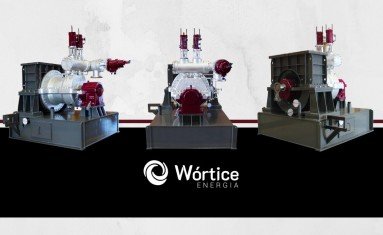Condensation Turbines – The Heart of Thermoelectric
In our previous post, we talked about pressure-reducing turbines, which are nothing more than back-pressure turbines. In this type of turbine, the steam that enters the machine has its pressure and temperature lowered, that is, there is an enthalpic fall, and from this enthalpic fall and the respective expansion of the steam, the energy that runs the rotor shaft is extracted.
The greater the difference between the enthalpy of the steam entering, and the enthalpy of the steam leaving the turbine, the greater the energy used. However, in most cases, when this enthalpy drop is not so great, the overall efficiency of the cycle can be compromised, and all the steam energy that could be used is not used.
In the case of vacuum condensing turbines, this problem is overcome, as the steam leaves the turbine at a negative pressure, that is, below atmospheric pressure.
Enthalpic drop, that is, the difference between pressure and temperature that enters the turbine, and the pressure and temperature that leaves the turbine, is much higher, which provides a better use of the energy contained in the steam, and consequently a greater overall efficiency of the power generation cycle.
For thermoelectric plants and applications where the only purpose is the generation of electric energy, this type of turbine is indicated.
And continuing on the steam cycle in this system, after it has been expanded inside the turbine, it leaves under vacuum to the condenser, where there is thermal exchange in contact with the tubes through which cold water circulates. The steam condenses, returning to the liquid phase and being pumped back to the boiler, where the entire cycle will restart.
This cycle is called the Rankine cycle
Wortice condensing turbines efficiently and at low operating cost meet this generation modality, being the state of the art in efficiency.
Applied to drive power generators, they have the best steam consumption ratio (kgv/kwh). The set is integrated and mounted on a single skid, taking up small space in the installation.
When applied in cogeneration systems, they have extraction, which directs part of the steam to the process under the required conditions, with the rest of the steam being condensed and returned to the boiler.
Do you want to know more? Contact us, or request a study for your requirements.
And know our blog, because soon we will have more posts and news from the sector.


